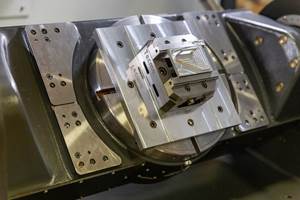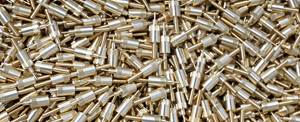5 Essential IIoT Definitions
Here are few of the most common terms used in discussions and articles about developments that promise seismic shifts in virtually every sector of manufacturing.

The cover of our August IMTS issue illustrates the concept of augmented reality in manufacturing—an example of the melding of physical and virtual that lies at the heart of IIoT.
Making sense of all the terms and catchphrases being bandied about to describe the Industrial Internet of Things can be difficult. Nonetheless, a common vocabulary is critical to facilitating the education required for broader development and adoption of technology that promises seismic shifts in virtually every sector of manufacturing.
In my position as an editor, precise language is particularly important. That’s why I’ve begun compiling a list of definitions for some of the most common words and phrases I’ve encountered in my own reading on the subject. Although by no means comprehensive, this practice has proven helpful in keeping my copy (and my head) as clear as possible on a subject that’s increasingly important to our readers. Beginning with a definition of IIoT itself, here are the meanings of five common terms associated with this technology:
1. Industrial Internet of Things (IIoT) is a term derived from the broader concept of the Internet of Things (IoT), which describes the increasing interconnectedness of the stuff we all use in our daily lives to one another and to the internet (or an intranet, or both). The idea is not just to exchange and collect data, but to act on that data to make things better. (One commonly cited example is a “smart” thermostat.) IIoT is the same concept applied to industry. Examples range from “smart” buildings and power grids to “smart” transportation networks. IIoT might initially take the form of a machine tool status monitoring system.

Large-screen TVs keep everyone at CNC Swiss-turning specialist Carolina Precision Manufacturing (CPM) aware of how closely machines are meeting their goals.
2. Data-driven manufacturing implies that manufacturing processes are driven forward by data—by facts, figures and other verifiable information, as opposed to guesses, assumptions and intuition. (It’s also the name of an MMS Online Zone where you can find everything we’ve written about IIoT).
3. Digital thread describes a closed loop of data from design all the way through engineering, a loop that often includes multiple, disparate processes conducted in multiple, disparate facilities. (A project recently instituted by the National Institute of Standards and Technology (NIST) is a prime example.)
4. Industry 4.0 is a term originally coined by the German government (“Industrie 4.0”) for a set of strategic initiatives aiming to expand development and adoption of the IIoT. The idea behind this term is that IIoT and cloud-computing technology—key ingredients of the so-called “smart factory”—are driving a fourth industrial revolution (following steam power, mass production and the digitalization of the manufacturing space, respectively).
5. Cyber-physical system (CPS). This is a specific term for what people mean when they talk about the “smart” technology that facilitates the IIoT. The National Science Foundation describes CPS as “engineered systems that are built from, and depend upon, the seamless integration of computational algorithms and physical components.”
In English, this means a physical device that’s controlled or monitored by a computer. Computer monitoring and/or control implies a connected device—one that can generate, send and receive data over a network. It also implies a feedback loop. That is, the device itself, or others to which it is networked, act upon data in real time to adapt to changing conditions. A basic example is an industrial vending system that automatically issues a purchase order when inventory reaches a certain level, or a machine with embedded temperature sensors that shuts off automatically when it gets too hot.
Although the CPS is the very root of the connection between the physical and virtual—the connection that, in turn, lies at the heart of the IIoT—this technology is still in its infancy. Continued development of these systems will lead to the much-touted “smart factory” of the future, in which facility-wide networks of connected machines use sensor data to automatically adjust all manner of process parameters.
Do you have a different understanding of any of these terms and phrases? What would you add to the list? Send an email or comment below.
Related Content
Diving Deeper Into Machine Monitoring Data
Data visualization is the first step in using machine monitoring data, but taking it to the next level requires looking for trends within the data.
Read MoreReinventing a Precision Shop With a Data-Driven Mindset
When this machine shop lost 90% of its business within three months, a reinvention was in order. Here's how it survived after quickly falling on hard times.
Read MoreShop Quotes Smarter, Works Harder with Machine Monitoring
Temco first installed MT-LINKi to optimize quoting. Now, the software helps the shop optimize its machines — and machine purchases.
Read MoreFinally, A Comprehensive Software Solution Designed for Small Job Shops
Zel X from Siemens is an integrated software application that consolidates collaboration, design, manufacturing, and operations into a comprehensive, easy-to-use solution. From RFQ to delivery, it’s a more efficient way to handle quotes, manage jobs, make parts, and collaborate with teams of all sizes.
Read MoreRead Next
3 Mistakes That Cause CNC Programs to Fail
Despite enhancements to manufacturing technology, there are still issues today that can cause programs to fail. These failures can cause lost time, scrapped parts, damaged machines and even injured operators.
Read MoreThe Cut Scene: The Finer Details of Large-Format Machining
Small details and features can have an outsized impact on large parts, such as Barbco’s collapsible utility drill head.
Read More


























